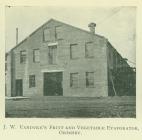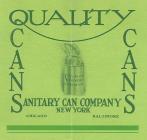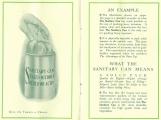1
PROCESSING FRUITSThere were four main industries in Grimsby that were involved with the tender fruit after it had been picked. These included: dehydration, preserving, canning, and shipping the fresh product to stores and markets as well as overseas. These industries required a lot of labour and many local citizens were employed in the fruit industry. Many businesses were opened in Grimsby and the surrounding area to take care of these needs.
2
THE FRUIT AND VEGETABLE EVAPORATOR AND JACK VAN DYKEIn the days before canning and electric refrigerators, many foods, especially apples were preserved by drying (dehydrating or evaporating). The Fruit and Vegetable Evaporator was owned and operated by entrepreneur Jack VanDyke. VanDyke was a local farmer who owned a seventy-four acre fruit farm. The building purchased to house the evaporating business was originally a military drill shed and stood at the corner of Depot (Ontario) and Adelaide Streets. In 1888, Jack VanDyke purchased and moved the building to Elizabeth Street and Victoria Avenue. This building was destroyed by fire in 1897 and a large cement building was constructed on Victoria Avenue to continue the evaporating business.
3
Jack VanDyke's Fruit and Vegetable Evaporator20th Century, Circa 1901
Victoria Avenue, Grimsby, Ontario, Canada
 Credits:
Credits:Grimsby Museum Collection
4
THE PROCESS OF DEHYDRATING FRUITA wood burning fire, located at the base of the dryer, was the early system of dehydrating fruit. Sliced apples were placed on trays and put at the top of the dryer. As the apples dried they were lowered towards the fire, and a new tray added above them. When the fruit was dry, it was removed from the trays put into boxes and sent to the packing room.
5
When VanDyke opened his second building he began to use a new method of dehydration. In this plant, apples were peeled and cored, but left whole. They were then placed in boxes, bleached in a sulphur oven and hoisted to the second floor where they were spread out on trays. The trays were stacked up to six feet high and loaded onto trucks. The trucks were wheeled into the evaporating box which was eight feet wide by eight feet long. At the front side there was an escape pipe for moisture and at the back an extensive system of steam coils and a fan to push the steam towards the apples. As evaporation took place, the piles of trays were moved closer to the heat. When dry, the apples were taken from the trays and packed into boxes for the market.6
VanDyke's Fruit and Vegetable Evaporator operated in the new cement building from 1897 to 1907 and employed many local residents. After it closed in 1907, the lower level was converted into an ice skating rink and the upper level into a roller rink. The "Grimsby Independent" in 1913 details the sale of the building to the Canada Steel Specialty Company and subsequent opening of this new factory.7
CANNING FRUIT IN GRIMSBYWith the large quantities of fruit being grown in the Grimsby area there was a need for a method to preserve and store the fruit. Canning was popular because it was portable and the cans required no refrigeration. Canning gave the produce a long shelf life and reduced spoilage. Peaches, apples, cherries, pears, tomatoes and other local tender fruits were canned. During the war years canned foods were sent to soldiers overseas. Much of the growth of Grimsby can be attributed to the growth of the canning industry.
8
EARLY CANNINGThe original tin cans were very labour intensive and made by hand. They were created by pounding iron into sheets, dipping them in molten tin (creating tin plate) and then cutting these sheets into pieces which were soldered together to create cylindrical shapes. One end was left open for filling with food and once filled, the opening was plugged with a metal cap that was soldered into place. These early cans were called hole and cap cans because of their construction. They were difficult to construct, and many workers could only make ten cans per day.
9
THE SANITARY CANWhen the sanitary can and mechanized production were introduced just after 1900, the process of canning became quicker, easier and profitable. The sanitary can is made by folding the edges of the sides and ends together, forming a strong seal. Industrial die cutting, machines to make the can bodies and machine-made tin plate allowed cans to be produced in larger quantities. The mass production of tin cans along with mechanization of the canning lines led to the expansion of the canning industry.
10
Sanitary Cans Pamphlet from the Quality Cans Company20th Century, Circa 1910
New York, New York, United States of America
 Credits:
Credits:Grimsby Museum Collection
11
Sanitary Cans Pamphlet from the Quality Cans Company20th Century, Circa 1910
New York, New York, United States of America
 Credits:
Credits:Grimsby Museum Collection
12
Haller's Improved Fruit Washer20th Century, Circa 1910
Pittsburg, Pennsylvannia, United States of America
 Credits:
Credits:Grimsby Museum Collection
13
Haller's Improved Filling Machine20th Century, Circa 1910
Pittsburg, Pennsylvannia, United States of America
 Credits:
Credits:Grimsby Museum Collection